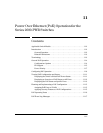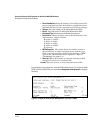
Power Over Ethernet (PoE) Operation for the Series 2600-PWR Switches
General PoE Operation
■ The number of switches drawing external PoE power from the HP 600
RPS/EPS or HP 610 EPS unit. If only a single switch is using external PoE
power the HP 600 RPS/EPS or HP 610 EPS provides 408 watts of PoE
power. If two switches are using external PoE power from the HP 600
RPS/EPS or two switches are connected to the same pair on the HP 610
EPS, a switch receives 204 watts of PoE power. Should the switch’s
internal PoE power supply fail, the HP 600 RPS/EPS or HP 610 EPS
provides power up to the wattage stated above.
■ When the internal PoE power supply fails, the HP 600 RPS/EPS reserves
a minimum of 38 watts for the less-loaded bank of ports. In the default
configuration, at a minimum, the first two ports in the bank (1 and 2 or 25
and 26) will have PoE power.
Note It is the ports configured with the highest priority of either bank (1-24 or 25-
48) that will receive PoE power. For example, if the highest priority ports have
been re-configured to be 23, 24 and 47, 48, then they will have PoE power.
■ In the default configuration PoE power priority is determined by port
number, with the lowest numbered port having the highest priority.
Power Priority
When Does the Switch Prioritize Power Allocations? If the switch can
provide power for all existing PD demands, it does not use its power priority
settings to allocate power. However, if the PD power demand oversubscribes
the available power, then the switch prioritizes the power allocation to the
ports that present a PD power demand. This causes the switch to remove
power from one or more lower-priority ports to meet the power demand on
other, higher-priority ports. (This operation occurs, regardless of the order in
which PDs connect to the switch’s PoE-configured ports.)
How Does the Switch Prioritize Power Allocations? The switch simul-
taneously uses two priority methods:
■ The priority class method enables port PoE priority class assign-
ments of Low (the default), High, and Critical.
■ The port-number priority method gives a lower-numbered port
priority over a higher-numbered port within the same configured
priority class.
Suppose, for example, that you configure PoE priority as shown in table 2.
11-7


















